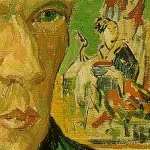
For Christmas, my wife gave me Harriot Scott Chessman's 2001 novel Lydia Cassatt Reading the Morning Paper. I hadn't read the novel before--I mentioned in an earlier post how long it takes me to get around to certain books--but now I'm glad that I have. In tone, scope, and character it's quite different from what I'm trying to accomplish in my Van Gogh novel. Chessman's novel spans less than three years of Mary Cassatt's life while mine survey almost all of Van Gogh's; her cast is decidedly female (these are the power brokers of Cassatt's world) while in my novel Van Gogh, as he did in life, exclusively surrounds himself with male friends and fellow painters. These two differences makes the atmospherics of our books strikingly different. Yet it's instructive and entertaining to see how a different fiction writer handles a different painter who worked during the same time period, and in the same country, as Van Gogh did. (Mary Cassatt, however, lived far longer than Van Gogh; all the way till 1926.)
Chessman's book is a supremely delicate one, focusing on the interior world of Cassatt's sister Lydia, whose life was drastically shortened by Bright's disease. The novel tells the the story of the composition of five paintings, paintings for which Lydia Cassatt modeled. In each successive painting we see her health deteriorate, even as she must also contend with feelings of regret for a life of marriage and children that could never be realized, her worries that her sister is becoming all too French in outlook, and simple jealousy over her sister's growing closeness with Edgar Degas, whom Lydia first suspects but then becomes infatuated with. This latter development creates a provocative triangle of mutual need, respect, and desire, the background against which Lydia struggles to put aside the inevitabily of her death and focuses on making life purposeful for months or years she has left. It's a deeply felt novel if at the same time decidedly airy, maybe too airy for some readers. As you can tell from this summary, the book is much more about Lydia--her frustrations, resentments, appetites, relationships, and priorities--than about Mary, although Mary (called May by her family) figures quite importantly.
A few stylistic nuances in the novel I questioned, such as the numerous times that French phrases are inserted into the conversations between Lydia and Mary. These are two native English speakers, after all. If the point is to remind us that the family lives in France, the point is reiterated more often than necessary. The motif of Lydia's dreams is bit overdone for my tastes. I was more interested in the real life details of Lydia's struggle against her disease and her disappointments. But these are minor reservations about a book I otherwise recommend. It's fascinating to see 19th century France--not just Paris but also the countryside--as it is imagined and interpreted by another novelist. Chessman's use of details seems impeccable and if nothing else, her lovely little book has rekindled the desire--no, the necessity--in me to return to "every man's second country," as Thomas Jefferson called it. Asap. And I just got back from there six months ago!













0 comments:
Post a Comment